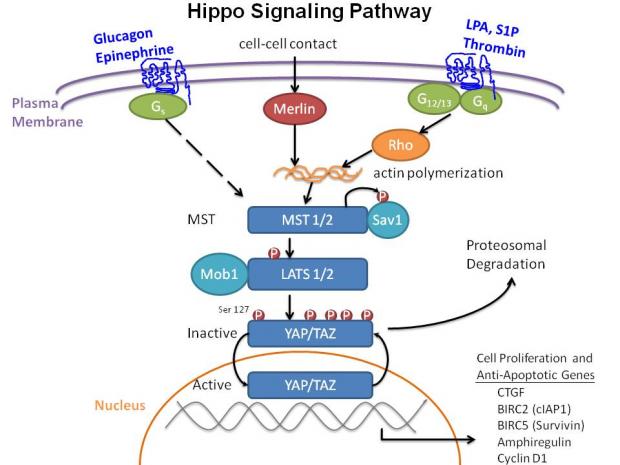Pathway Type:

| Attachment | Size |
|---|---|
| 103.19 KB |
The Hippo signaling pathway kinase cascade regulates organ size by controlling proliferation and apoptosis. It was originally discovered in Drosophila by screens for genes which when inactivated led to organ overgrowth. The pathway is named for Hippo (Hpo), a Ste20 protein kinase. Components of the pathway are conserved in mammals with Mst1/2 playing the equivalent role to Hippo. Mst1/2 phosphorylates Lats1/2 and Lats1/2 phosphorylates Yap or its paralog Taz. When phosphorylated Yap is held in the cytoplasm bound to a 14-3-3 protein or degraded by the proteasome. When not phosphorylated, Yap moves into the nucleus to regulate the transcription of pro-proliferative and anti-apoptotic genes as a transcription coactivator. Upstream control of the Hippo pathway is by cell-cell interaction and G protein coupled receptors. Receptors coupled to G12/13 or Gq activate in a Rho and actin dependent manner while receptors coupled to Gs inhibit. At this point it is unknown if CCK, secretin, VIP or other pancreatic regulators affect the pathway in pancreatic cells. LPA and S1P are known to mediate the effects of serum. It is also unknown whether the pathway will regulate mature, dedifferentiated or stem cells in the pancreas but a recent paper showed acinar degeneration and pancreatititis like phenotype when Mst1/2 was deleted (George et al, MCB 32:5116, 2012).
Reviews
- The Hippo signaling pathway in mammalian cells with specific coverage of the pancreas
Components
- Amphiregulin
- BIRC5
- cIAP1
- CTGF
- Cyclin D1
- Galpha s
- Galpha 12/13
- Lats1/2
- Mob1
- Mst1/2
- Rho A
- Sav1
- TEADs
- Yap/Taz

